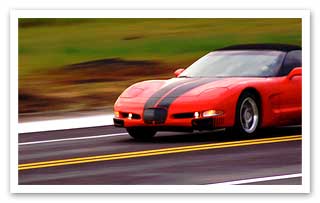Speed Laws
Generally speaking, you should drive with the flow of traffic. That means you should drive at the same speed as the main stream of traffic around you. Driving much slower or faster than the traffic around you is dangerous.
Keep in mind that there are minimum speed limit laws as well as maximum speed limit laws. If you go slow enough to impede or block the movement of traffic, you could be issued a ticket.
There are certain times when you should drive below the speed limit. Drivers must slow down when approaching and crossing an intersection, going around a curve,
approaching the top of a hill, or traveling on a narrow and winding road. Adverse weather, traffic, and pedestrians may also require you to drive below the posted speed limit.
Keep track of your speed by glancing at the speedometer frequently and keeping with the flow of traffic. When you drive a vehicle, it can be easy to lose focus of your speed if you’re not paying attention.

Speed laws vary by state. Speed limits change depending on the type of vehicle you're driving (e.g., large trucks are often required to drive at a lower speed than passenger vehicles)
and the road you're on. Residential and rural roads often require slower speeds than highways and freeways.
Take a look at the video below to learn more about speed laws.
The Payoff from Speeding
Speeding is dangerous. It affects your vision, stopping distance, and chances of surviving a crash, because:
- Peripheral vision (i.e., seeing out of the corner of your eyes) decreases
- The time it takes for you to stop increases
- The force of impact increases, making collisions more dangerous and increasing the chance of injury
- Your chances of survival in a collision decreases
If you travel 55 mph when there's a 50 mph speed limit, you’ll only get to your destination about 1 minute and 6 seconds sooner than if you had followed the speed limit.
If you traveled about 10 mph over that posted speed limit, you’re only saving yourself about 2 minutes. If you travel 20 mph over that speed limit, you’re only saving yourself about 3 minutes and 26 seconds.
That's not a huge payoff for a whole lot of risk.
Adjusting Speed for Poor Driving Conditions
A good driver knows to slow down when the road is wet (with rain, snow, or sleet). A little rain can make a lot of trouble for drivers who don’t know how slick a wet road can be.
A car is harder to control on a wet road and can even become out-of-control. Slowing down is the only wise choice! This will help you keep control of your car in rainy weather.

You should also slow down when the road is crowded. A higher number of vehicles on the road makes for less space and more opportunities for a collision.
Finally, always slow down if your vision is limited. No one can drive a car well without seeing the road properly.
A good rule of thumb is to make sure you can stop within the distance that you see ahead of your car. In darkness or bad weather, when you cannot see far ahead, adjust your speed and don’t drive too fast.
A good driver adjusts their speed to fit the situation. If you don’t feel well, take your time and drive cautiously.
Better yet, if you’re too tired or not feeling well, don’t drive at all. Never force yourself to drive when you’re not feeling well enough to do so safely.
Avoid Speeding Drivers
Even if you’re not the one speeding out there on the roadway, other speeding drivers can pose a real threat. Take a look at the following video to find out how to safely avoid them.
Take a Course to Learn More
If you enjoyed this article and are interested in learning more about driving-related topics, you should check out our courses on www.safe2drive.com.
We offer courses in a variety of topics including Defensive Driving and Driver Education. In addition to teaching you how to be a safe driver, our courses
can help you dismiss a ticket, get your driver license, or even get an insurance discount. We also have courses specifically tailored to mature drivers (i.e., drivers
age 55 and older) for insurance discounts.